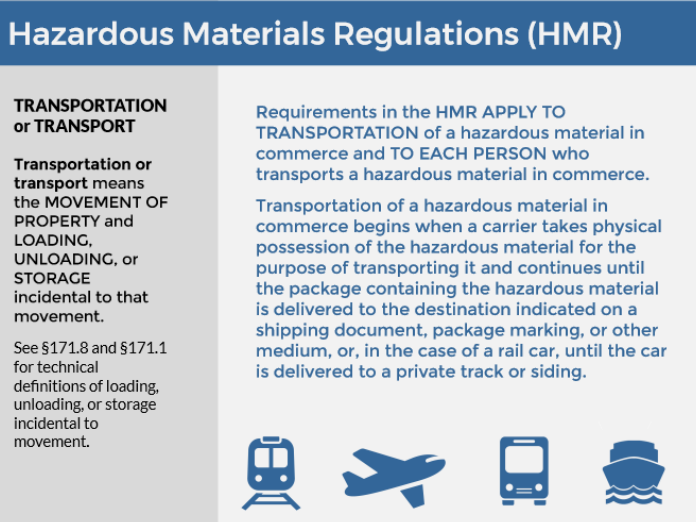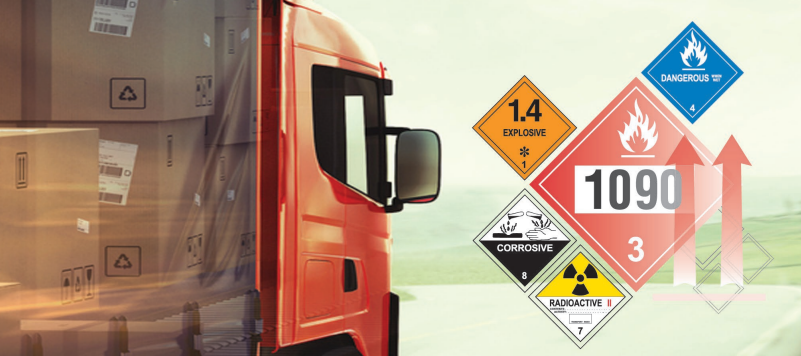
Hazardous Materials Regulations
Hazardous materials are defined and regulated in the United States by Federal agencies, including the U.S. Environmental Protection Agency (EPA), the U.S. Occupational Safety and Health Administration (OSHA), the U.S. Department of Transportation (DOT), and the U.S. Nuclear Regulatory Commission (NRC).
Hazardous Materials Definition
A hazardous material is a substance or material that the Secretary of Transportation has determined is capable of posing an unreasonable risk to health, safety, and property when transported in commerce, and has designated as hazardous under section 5103 of Federal Hazardous Materials Transportation Law (49 U.S.C. 5103).
The term includes:
| Hazardous Substances | Hazardous Wastes | Marine Pollutants |
| Elevated Temperature Materials | Materials Designated as Hazardous in The Hazardous Materials Table | Materials that Meet the Defining Criteria for Hazard Classes and Divisions in Part 173 of the HMR |
The Pipeline and Hazardous Materials Safety Administration (PHMSA) is responsible for regulating and ensuring the safe and secure movement of hazardous materials to industry and consumers to, from, or within the U.S. by all modes of transportation: highway, aircraft, rail, and vessel. To minimize threats to life, property and the environment, PHMSA’s Office of Hazardous Materials Safety develops regulations and standards for the classification, packaging, and communication of hazardous materials.

PHMSA - Guide to Developing a Hazmat Training Program, An Employee who loads, unloads, or handles hazmat; Until training is completed, a hazmat employee must be directly supervised by a person who has been trained.
GENERAL AWARENESS/FAMILIARIZATION TRAINING is training that provides familiarity with the general requirements of the HMR, and enables the hazmat employee to recognize and identify hazmat. All hazmat employees must receive general awareness training.
FUNCTION-SPECIFIC TRAINING is training that provides a detailed understanding of HMR requirements applicable to the function(s) performed by the hazmat employee. Each hazmat employee must be trained on the specific functions they are required to perform.
SAFETY TRAINING is training that covers the hazards presented by hazmat, safe handling, emergency response information, and methods and procedures for accident avoidance. All hazmat employees must receive this training.
SECURITY AWARENESS TRAINING is training that provides a general understanding of the security risks associated with hazmat transportation and the methods designed to enhance transportation security. This training should include methods on how to recognize and respond to possible security threats. All hazmat employees must receive this training.
To learn more about Hazardous Materials Regulations please review the following student workbooks.
Please click on each link below to download a pdf of the Student Workbook for EACH module.
0.0 Hazardous Materials Regulations Introduction -12 pages
1.0 Hazardous Materials Table - 52 pages
2.0 Shipping Papers - 39 pages
7.0a Carrier Requirements - Highway - 31 pages
7.0b Carrier Requirements - Air - 46 pages
7.0c Carrier Requirements - Rail - 41 pages
7.0d Carrier Requirements - Vessel - 35 pages
8.0 Security Requirements - 24 pages
7 Useful Tips Quick e-Resource Guide - To Help You Ship Hazardous Materials Safely in Commerce
The Hazardous Materials Transportation Training Modules also include interactive training functionality for enhanced instruction. The training modules are available at:













